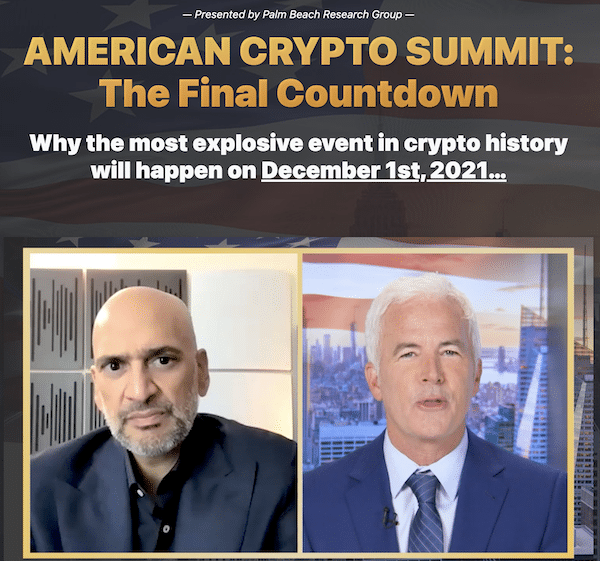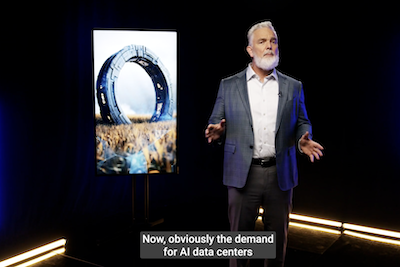In a presentation titled “The American Crypto Summit: The Final Countdown,” Teeka Tiwari explains why he believes the “most explosive event in crypto history” will occur on December 1, 2021.
He calls this event the “Final Countdown” and says it could “send the crypto market soaring into the stratosphere.”
What is the “Final Countdown” event? And what cryptos is he teasing?
That’s what I intend on shedding some light on in this article. I’ll give you the full details behind this so-called “final countdown event” and what crypto opportunities he’s bullish on.
I’ll also give you the heads up on the advisory service he’s pitching, Palm Beach Letter, to help you decide if it’s worthwhile.
What Is The “Final Countdown” Event?
The presentation I’m looking into today is located on the Palm Beach Research Group website, and it’s essentially an “interview” between John Burke and Teeka Tiwari.

John Burke is the host of the presentation, and he begins by saying that, according to Teeka Tiwari, “we are less than 30 days away from what could be the most profitable event in crypto history.” An event Teeka Tiwari called “the final countdown.”
He also says that the Final Countdown was originally “scheduled to happen next summer, 2022,” but the “situation has escalated faster than anyone anticipated.”
There’s a healthy dose of marketing “fluff” in this presentation, so I won’t bore you with a play-by-play of everything that was talked about. Instead, I’ll sum it up for you real quick:
- Teeka says there’s a “supply shock coming to this one crypto” and that “on December 1st” a change is coming “that will speed up a massive supply cut.”
- He likens it to the bitcoin halving, where the block reward is halved roughly every four years, and (in a roundabout way) suggests that the “massive supply cut” for the crypto he’s recommending could drive up its price.
- Towards the end of the presentation, Teeka reveals that his “#1 Crypto Recommendation” is Ethereum.
- He also says there are “two tiny cryptos” that he believes are “poised for explosive growth” as we approach the “Final Countdown.” And four “behind-the-scenes companies” that are “laying the groundwork, the infrastructure, for crypto to go mainstream.”
That about sums up the remainder of the presentation. From there, Teeka talks about how you can access his picks through two research reports that come as a bonus for joining Palm Beach Letter. But before we get to that, let’s dig further into what this “Final Countdown” event is.
In short, the “event” Teeka is referring to is something called the “difficulty bomb.”
What’s that?
The difficulty bomb is a term used to describe an increase in the difficulty of mining Ethereum that is achieved by increasing the time it takes to mine each block.
Put differently, it makes it harder for people to mine Ethereum.
Why does the difficulty bomb exist?
The idea behind the difficulty bomb is to disincentivize the mining of Ethereum by making it unprofitable. And the reason behind this is that Ethereum is transitioning away from Proof of Work (PoW) and into Proof of Stake (PoS).
I recommend checking out this article on Kraken about the difference between Pow and PoS. But in short, these are two different consensus mechanisms. In other words, two different ways of verifying the transactions that take place on a blockchain.
There’s a lot of debate over which consensus mechanism is better, Pow or PoS. And we’ll dig into that towards the end of the article. But for now, the important thing to know is that the “final countdown event” Teeka refers to in the presentation is the difficulty bomb.
And it’s set to “explode” on December 1, 2021.
However, the more I dug into this, the less certain it looks that December 1, 2021, will be the date the difficulty bomb is activated because it has been changed numerous times.
Let me explain…
Based on this article on gfinityesports.com, the difficulty bomb was initially set to “go off” in the second quarter of 2022 with the London Hard Fork.
This is what John Burke was talking about in the presentation when he said, “originally, the Final Countdown was scheduled to happen next summer, 2022.”
However, the date for the difficulty bomb was brought back to December 1, 2021, to coincide with Ethereum’s EIP-3554 update. Which the following CNBC article confirms:
EIP-3554 moves up the detonation date of the difficulty bomb by six months to December, and once it goes off, it will ultimately make ethereum “unmineable.”
However, according to the gfinityesports.com article I just linked to, the date has changed again. This time, it’s expected to take place in June 2022:
Since then, Beiko, alongside James Hancock, released a new Ethereum Improvement Proposal (EIP) – EIP-4345 – which would delay the difficulty bomb until June 2022.
So to recap… it was meant to happen in the second quarter of 2022, then it was brought back to December 2021. Now it looks like it “might” occur in June 2022 (lol).
And I say “might” because, according to this October 2021 Coindesk article, the June 2022 date is not set in stone. What’s more, the same article points out that the difficulty bomb has been delayed four times since it was originally introduced in 2015.
So my point is, the “final countdown event” (AKA Ethereum difficulty bomb) might happen on December 1, 2021, as Teeka Tiwari and John Burke suggest.
However, it could also occur eight months from now. Or, considering it’s been moved about so many times already, at some other time entirely.
What’s the big deal about the difficulty bomb, anyway?
It’s all about disincentivizing PoW mining and “forcing” the transition into PoS by making it more difficult to mine Ethereum. And this is part of the transition into “Ethereum 2.0.”
Also, according to this May 2020 article on Cointelegraph, one of the reasons Vitalik Buterin (founder of Ethereum) is transitioning to Proof of Stake is to “greatly reduce the issuance.” Here’s a snippet from the above article (which is quoting Vitalik Buterin):
“One of the reasons why we’re doing Proof of Stake is because we want to greatly reduce the issuance. So in the specs for ETH 2.0 I think we have put out a calculation that the theoretical maximum issuance would be something like 2 million a year if literally everyone participates.”
So when Teeka said the “final countdown event” could cut the supply by “as much as 90%,” it looks like he’s basing that off Vitalik’s statement from the above Cointelegraph article.
And if what Vitalik said does happen, that would be a significant supply reduction. However, keep in mind that the 2 million per year issuance figure is a “theoretical maximum.” Like the date for the difficulty bomb, the rate of future issuance for Ethereum is not set in stone.
How would a supply reduction impact Ethereum’s price?
Nobody can say for sure what the future price of any asset will be. However, according to the law of supply and demand, less supply of a good with the same or higher demand theoretically can lead to higher prices. So, theoretically, reducing Ethereum’s supply could cause its price to rise.
To be clear, I am NOT suggesting that the price of Ethereum will go up due to the difficulty bomb. Or for any reason at all, for that matter. Nor am I endorsing Teeka’s pitch. I am simply sharing what I’ve learned and my thoughts/opinions on the matter.
So, please do not consider anything on this page to be financial advice. It’s not. And in case you’re wondering, no… I do not own any Ethereum, directly or indirectly.
Nor am I planning on buying any. The only “crypto” I hold is bitcoin. So it’s probably best to assume I’m completely biased when it comes to the altcoin versus bitcoin debate.
In any case, to sum it up… in the American Crypto Summit, Teeka Tiwari talks about a “final countdown event” that is all about Ethereum’s difficulty bomb that is set to go off in December of 2021 or June of 2022. Which he says could lead to a “massive supply cut.”
And while he doesn’t outright say it, he more or less suggests that this “event” could turn out to be a lucrative opportunity for investors who get in before that date.
He also mentions some other crypto-related opportunities in the presentation.
And I think I may know what one of them is.
What Are Teeka’s “Two Tiny Cryptos” and Four “Backdoor Profit Plays?”
During the presentation, Teeka said that “a select few smaller coins will outperform Ethereum.” And he details two of his top picks in a report titled “The Final Countdown Buy List: Two Tiny Cryptos to Own Now.”
He also says he’s buying “behind-the-scenes companies that are laying the groundwork, the infrastructure, for crypto to go mainstream.” And he details his top four picks in a research report titled “The Final Countdown: Ultimate Backdoor Profit Plays.”
He doesn’t reveal the names of any of these. All he really says about the cryptos is that one of them trades for “just over $1” and is backed by some big-name companies like Coinbase.
However, he does provide a clue about one of the “backdoor profit plays” he’s bullish on, and based on my research, I believe that one of these companies is Bakkt Holdings (BKKT).
Why?
Firstly, because he describes one of these “backdoor profit play” companies as an exchange or “toll taker.” And what he described reminded me of a presentation I wrote about on July 21, 2021 (updated September 30, 2021) about “Genesis Technology.”
Otherwise known as his “investment of the decade” presentation.
You can see the full article here. But to summarize, based on the clues he provided in that presentation, I came to the conclusion that one of the companies he was teasing was Bakkt.
And what he says in the American Crypto Summit presentation sounds very similar to what he said about Bakkt in the “Genesis Technology” pitch.
Not to mention, Teeka also says that the CEO has been called a “prolific wealth creator.” And the CEO of Bakkt was described as a “prolific wealth creator” in an article on thestreet.com.
So, my guess on one of Teeka’s picks is Bakkt, which is essentially a crypto exchange.
And at the time I first published the article I linked to earlier, it was still a private company. However, my understanding is that it went public through a SPAC called VPC Impact Acquisition Holdings in October. And either way, it’s now trading as Bakkt Holdings, Inc.
There are no guarantees I’m right, but if I am, kudos to Teeka because Bakkt has almost tripled in price since I first published that article. So his readers could’ve done well.
Anyway… to find out for sure what cryptos and stocks he’s teasing, you’d need to read the reports I mentioned earlier. And the only way to access those is to join Palm Beach Letter for $49.
What Is Palm Beach Letter?
Palm Beach Letter is an investment advisory service run by Teeka Tiwari of Palm Beach Research Group. Each month, Teeka sends out his latest investment recommendations and insights to subscribers via the newsletter, as well as updates on any positions he’s recommended.
The newsletter is mostly focused on tech stocks and crypto, but Teeka recommends a variety of opportunities depending on what he and his team uncover through their research.
On top of the newsletter, you also get access to the model portfolio, video training, and some bonus reports. Which reports you receive and how much the service costs depend on which page you join through.
In this case, it costs $49 for 12 months access, and you get the following bonus reports:
- The Final Countdown Buy List: Two Tiny Cryptos to Own Now
- The Final Countdown Ultimate Backdoor Profit Plays
- The Bitcoin Boost: How to Supercharge Your Crypto Gains With the 1170 Account
The first two reports are the ones I mentioned earlier. The last report is all about earning interest on your bitcoin through an “1170 account,” and I explain the full details about that in my review of another presentation he released about inflation.
According to the Palm Beach Research Group website, the Palm Beach Letter model portfolio “has delivered an average return per the recommendation of 281%” since 2016.
That’s impressive. And I think it’s primarily due to his bitcoin recommendation in 2016 when it was trading at $428 per coin. But Teeka has recommended a bunch of altcoins and some great stocks over the years, too. And either way, he has one of the best track records in the space.
That doesn’t mean you’re guaranteed to make lots of money as a member of Palm Beach Letter because past performance is not a reliable indication of future performance… and all that.
But he knows his stuff and has proven that time and time again. He’s also a former hedge fund manager with over three decades of experience, so there’s that.
Bottom Line
The “final countdown event” Teeka Tiwari talks about in the American Crypto Summit presentation is about Ethereum’s “difficulty bomb,” which is supposed to occur on December 1, 2021, or sometime in June of 2022.
The purpose of the difficulty bomb is to increase mining difficulty in a bid to transition Ethereum into a Proof of Stake (PoS) cryptocurrency with the release of Ethereum 2.0.
Exactly when, or even if, this “event” will occur is unclear because Ethereum’s difficulty bomb has been delayed four times already. And assuming it does happen, there’s no guarantee it will positively impact Ethereum’s price. It might, but there’s no guarantee.
Another point I want to make is that there’s a good reason why bitcoin uses Proof of Work (PoW) instead of Proof of Stake (PoS). A reason that I encourage you to explore for yourself.
In short, the argument is often made that bitcoin’s PoW consensus mechanism “uses too much energy,” and that’s why some claim PoS is better.
But after spending (literally) hundreds of hours learning about bitcoin, I have come to the conclusion that this is a fundamentally flawed argument.
And there are two main reasons I say this.
First, bitcoin mining does require a lot of energy, yes, but that energy usage isn’t a problem when you take a closer look at the facts.
The article I just linked to goes into detail on this topic and explains why bitcoin’s energy use isn’t a problem better than anyone. So I recommend checking that out. But the following are some of the key reasons I say bitcoin’s PoW is not boiling the ocean as some claim.
- Bitcoin only uses a small amount of energy relative to global energy consumption, especially considering how much wealth it secures.
- Bitcoin mining is becoming increasingly energy-efficient. More and more miners are switching to using cleaner energy sources over fossil fuels. Most recently, El Salvador started mining bitcoin using volcano energy. Yes, they’re minting bitcoin from the energy a volcano produces.
- Some bitcoin mining companies are using stranded (wasted) energy that is harmful to the environment, like flared gas, which is directly reducing carbon emissions.
- Bitcoin mining incentivizes renewable energy because it acts as the “buyer of last resort.” As an example, bitcoin has the potential to help a remote solar farm become profitable where it otherwise would not have been. And this can help spur economic growth in remote locations and emerging economies.
In a nutshell; bitcoin changes the incentive structure. And even though it uses a lot of energy, that doesn’t mean its energy usage is a problem for the environment. Especially not when you consider the benefits bitcoin brings to the world.
The second reason I believe bitcoin’s PoW consensus mechanism is superior to PoS is because of one fundamental reason – decentralization.
The importance of decentralization cannot be overstated; it’s the whole reason bitcoin was created. To establish an open monetary network that doesn’t require trust in a third party.
And PoS is not as decentralized as PoW.
Why? Because, with PoS, the wealthiest individuals control the network. The idea with PoS is that the more “stake” you have in a crypto project, the more control you have over how it works.
It’s similar to having shares in a company. The more shares (crypto) you own, the more say you have over how the company (protocol) functions.
That mechanism works well for public companies and shareholders, but it’s not a good thing if you want the asset to be decentralized – because it concentrates power into the hands of a few, those who hold the most crypto.
Whereas with bitcoin’s PoW consensus mechanism, you don’t need to own any bitcoin at all to set up a miner and share the rewards of helping secure the network. It doesn’t matter who you are, where you’re from, or how much money you have.
Granted, miners aren’t free or cheap. But mining rigs are becoming more efficient with time, and there’s a lot of innovation taking place that allows virtually anyone to take part in mining without even buying a mining rig.
Anyway, I’ll leave it at that. There’s so much more to it than this, but we’d be going well beyond the scope of this article if I continued.
To sum it up… bitcoin’s PoW is a feature, not a bug. It is not something to be “fixed” or “upgraded.” PoW was purpose-built into bitcoin for a reason – decentralization.
Whether you agree, disagree, or don’t care about the consensus mechanism, is up to you. But hopefully, what I’ve shared gives you some more insight into this topic.
And either way, concerning the Palm Beach Letter, it’s a genuine service.
I mean, there’s no guarantee it’ll help you make money. And as I’ve explained, the “final countdown event” may or may not occur on December 1, 2021. But the presentation isn’t a scam, and Palm Beach Letter is a legitimate service. So depending on your goals and investing preferences, you might find the service to be worthwhile.
Whatever you decide, thanks for reading, and I hope you found this helpful.





Please note: By submitting a comment using the above comment form, you confirm that you agree with the storage and handling of your data by this site as detailed in our Privacy Policy.